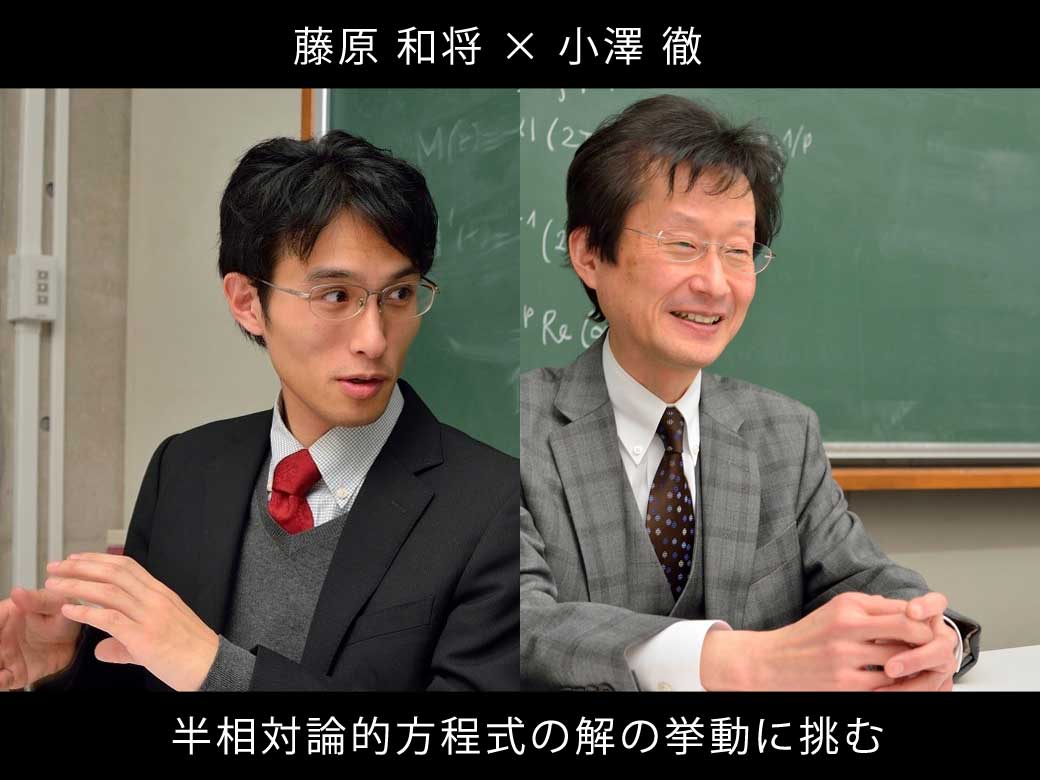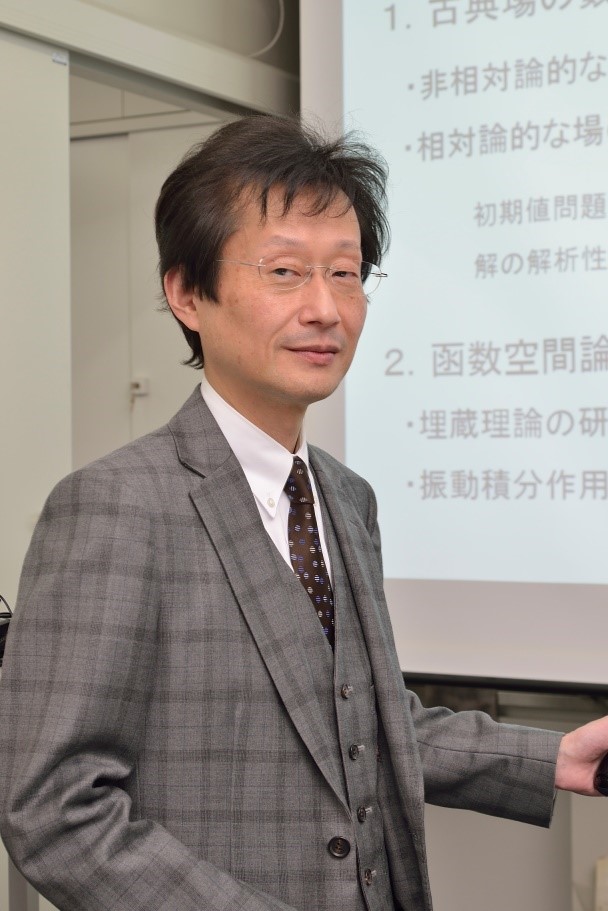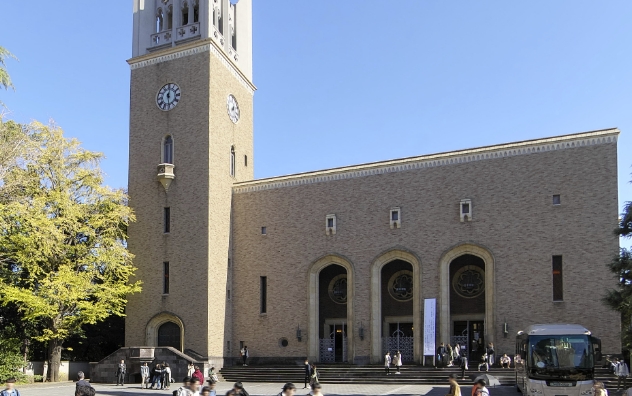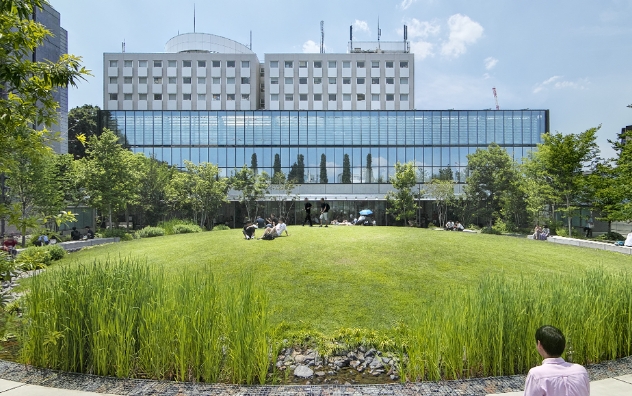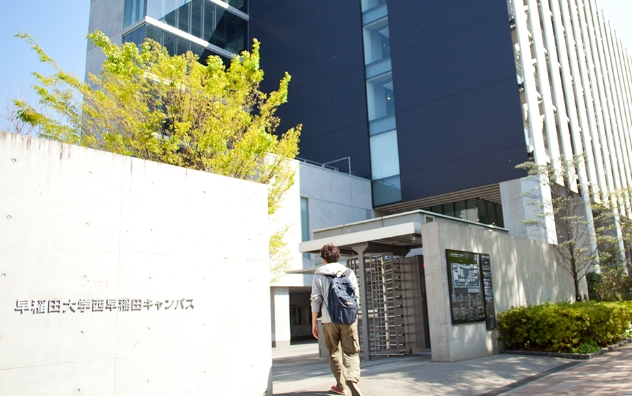Waseda Frontline Research Vol. 9, Part 2 – Explaining physical phenomena – The supreme power of mathematics
Tue, Mar 22, 2016-
Tags
Mathematical physics research
Professor Tohru Ozawa, Faculty of Science and Engineering (Department of Applied Physics, School of Advanced Science and Engineering)
Kazumasa Fujiwara, second year doctoral student, Graduate School of Advanced Science and Engineering (Department of Physics and Applied Physics), Recipient of 6th Ikushi Prize (2015)
Young researcher and Ikushi Prize winner challenging the ways to solve semirelativistic equations

Kazumasa Fujiwara, a co-researcher with Professor Ozawa, was awarded the 6th Ikushi Prize from the Japan Society for the Promotion of Science in 2015 for his research on “Mathematical Foundations of Semirelativistic Nonlinear Fields.” To commemorate this achievement, we met with the young researcher and his mentor Professor Ozawa to discuss mathematical physics.
Understanding the ways in which we solve semirelativistic equations
Ozawa: Congratulations on receiving the Ikushi Prize. It is wonderful that two students from our university have become the first Waseda researchers to win this award. First, can you share with us some details from your current research?
Fujiwara: My research is on the mathematical basis of semirelativistic equations, one of the model equations of the special theory of relativity. A particular goal of my research is to grasp the behavior of solutions that evolve with time based on relativistic equations that accompany interaction. Semirelativistic equations are partial differential equations, but it is extremely difficult to write down the solution to a partial differential equation that accompanies interaction. Therefore, in order to understand the behavior of solutions to semirelativistic equations, I am studying semirelativistic equations from the following three perspectives.
I. If limited to a short time, does there exist a unique solution that abides to a semirelativistic equation?
II. Can the solution proven in (I) be proven in a lengthened timeframe?
III. As we get closer to conditions from the initial time, does solution behavior also get closer?
The above three properties vary greatly depending on the form of interaction and the smoothness of the initial condition and the solution. Therefore, I am studying all three properties with each type of interaction and at different levels of smoothness. The differences between past research and my research are as follows.
1. Research into semirelativistic equations that accompany secondary interaction
In this research, regarding solutions rougher than in existing research, I identified the forms of interaction in which the semirelativistic equation system fulfills I, II and III. In addition, I demonstrated that the corresponding solution is a long-term solution based on charge, which is conserved quantity.
2. Research into semirelativistic equations that accompany gauge invariance
In this research, I introduced a new methodology regarding the structure of solutions in the framework of energy, which is conserved quantity.
3. Research into semirelativistic equations that does not accompany gauge invariance
In this research, regarding semirelativistic equations for interactions that do not accompany gauge invariance, I demonstrated that, depending on the initial condition, no solution exists if limited to a short time.
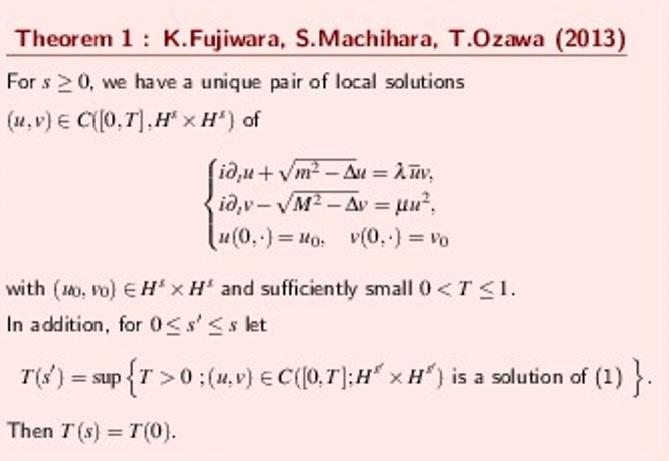
The main theoerm of『Well-posedness for the Cauchy problem of a system of semirelativistic equations』presented in One Forum, Two Cities 2013: Aspect of Nonlinear PDEs by Kazumasa Fujiwra, Shuji Machihara, and Tohru Ozawa.
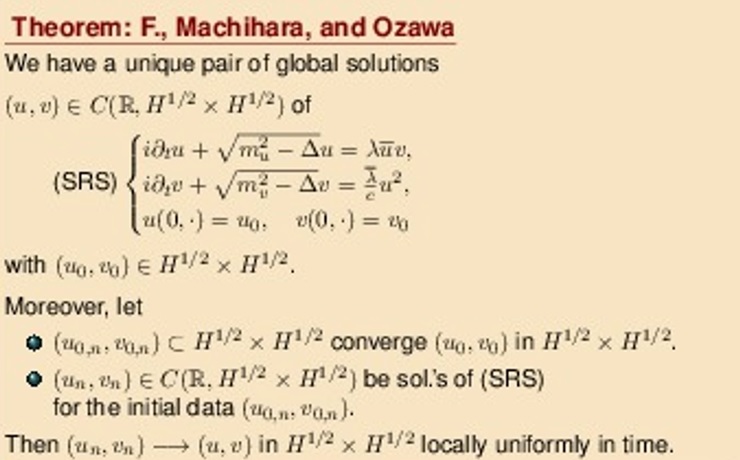
The main theorem of『The Well-Posedness of the Cauchy Problem for a Semirelativistic System』presented in The 10th AIMS Conference on Dynamical Systems, Differential Equations and Applications by Kazumasa Fujiwra, Shuji Machihara, and Tohru Ozawa.
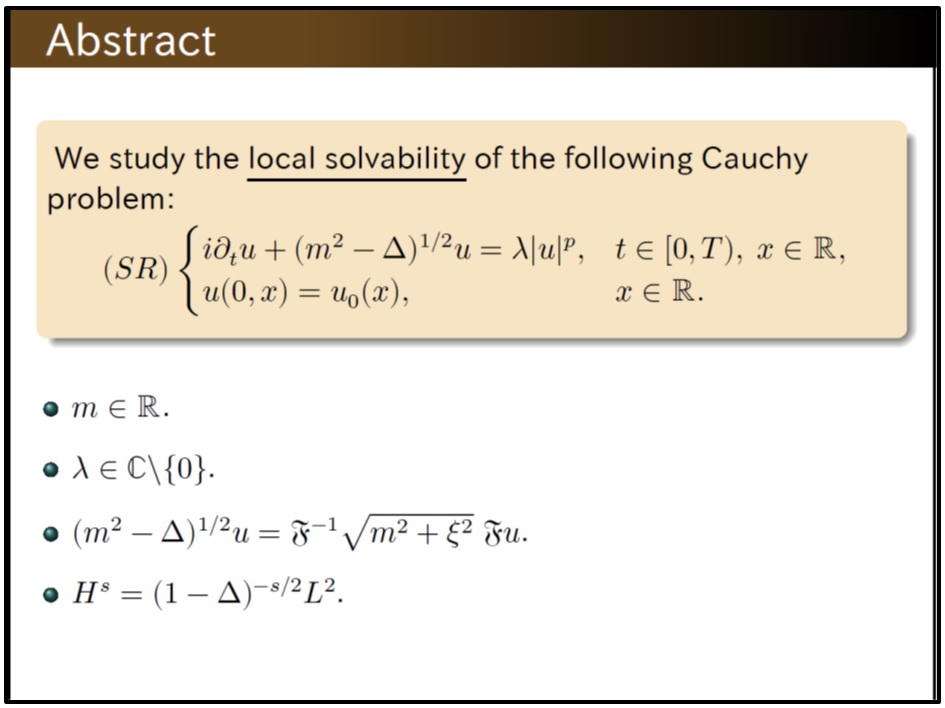
The abstract of『Remark on local solvability of the Cauchy problem for semirelativistic equations』presented in Fundamental Problems in Mathematical and Theoretical Physics by Kazumasa Fujiwara
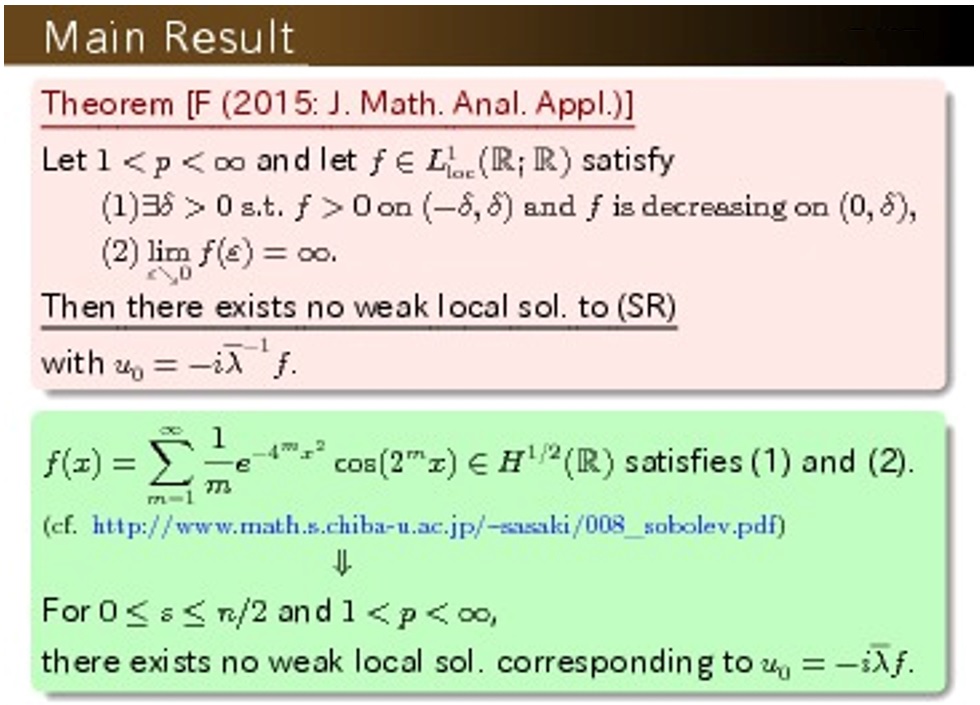
The main theorem of『Remark on local solvability of the Cauchy problem for semirelativistic equations』presented in Fundamental Problems in Mathematical and Theoretical Physics by Kazumasa Fujiwara
Ozawa: How did you deepen your learning at the University of Pisain in Italy where you studied for around two months starting from last October?
Fujiwara: Under Professor Vladimir Georgiev, I studied the evaluation of function smoothness and solutions to equations. The problem is how to evaluate the smoothness of a product of functions by the functions themselves, and whether a long-term solution exists in the case of slightly extreme settings. Professor Georgiev came to Japan in February last year for an intensive course, and meeting him led to my studying in Italy. Fortunately, I was selected by JSPS as a DC1 research fellow just when Waseda University became part of the Top Global University Project, both of which helped to make my short-term overseas study a reality. During my stay, Professor Ozawa also came to Pisa. In this brief overseas study, I was able to systematize the evaluation of products of functions from a greater perspective, and conduct new research into semirelativistic equations in multiple spatial dimensions.
Ozawa: I have known Professor Georgiev for more than 20 years. I first met him at an international research convention held at Hokkaido University (which I belonged to at the time), where he was invited to by Professor Yoshihiro Shibata of the Department of Mathematics. In February last year, Professor Georgiev showed interest in my research into the smoothness of products of functions here with Fujiwara at Waseda. Professor Georgiev is also a mathematics scholar who began in physics. Therefore, his fundamental way of thinking is very similar to ours. I think you were able to learn something new because you discussed with him the conditions needed for a solution to exist.

The poster for an internatinal workshop on “Fundamental Problems in Mathematical and Theoretical Physics” held by Mathematics and Physics unit, “Multiscale Analysis, Modelling and Simulation” of Top Global University Project of Waseda university. (Source: Tohru Ozawa)
The viewpoint desired from a researcher
Ozawa: Why do you think you received the Ikushi Prize?
Fujiwara: The truth is I thought I messed up the interview. The interview exam was held during my stay in Italy, and I felt I should have spent more time preparing. However, you made time to meet with me the day before, and the advice you gave me was just right. You gave me two important pieces of advice. The first was to treat the interviewer with respect. In other words, I should read the intent behind the questions and tailor my answers accordingly. The other piece of advice was to assume that the interviewer was probably a physicist, and so not to cater my answers to mathematicians but to people outside the mathematics field. In particular, I was surprised that some of the questions you predicted came up in the actual interview exam.
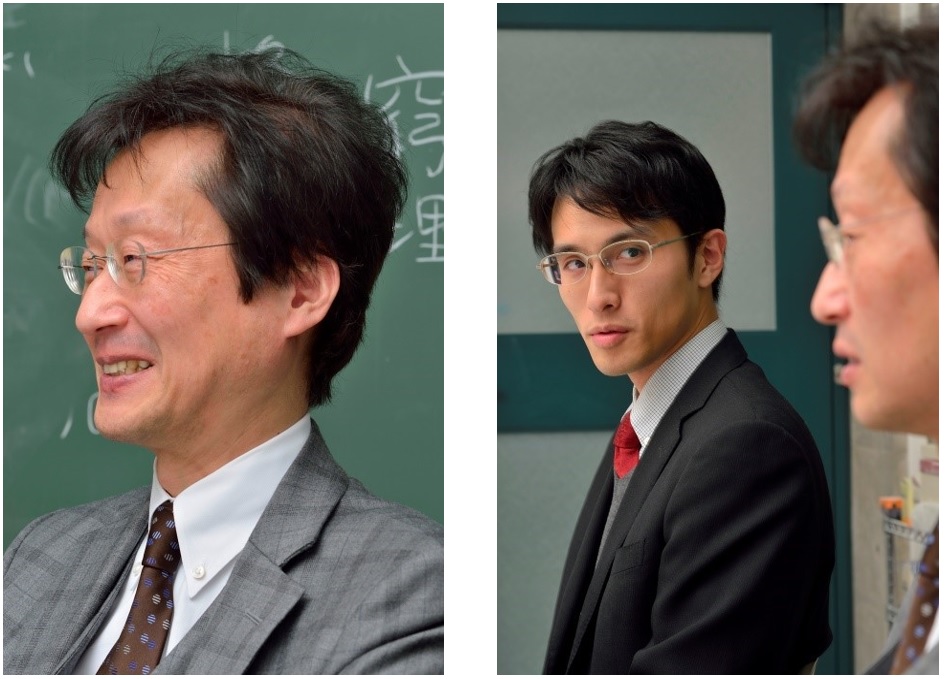
The requirements of a researcher. Professor Ozawa speaks with a smile while Mr. Fujiwara looks on respectfully.
Ozawa:There were probably no mathematicians among the interviewing professors, and the theme was physics related, so your answers had to be understandable to physicists in order to receive a positive evaluation. I remember thinking about how a physicist would deal with your equations if he saw them. Now that you received the prize, I hope you will complete your degree quickly and get out of here. You are able to write a research paper on your own now, so I want you to go on and become a scholar in your own right.
Fujiwara: When I was wondering whether to become a teacher, you told me to aim for research, and that is what prompted me to become a researcher. I will devote myself to becoming a scholar in my own right.
Ozawa: One of your strengths is that you never give up thinking about something until you understand it. I think the first question I got from you was during a lecture on complex function theory, and you were quite persistent. Research focuses on subjects in which we do not even know the right questions. Therefore, only those who are able consistently think up until the point where they understand the topic on their own can become researchers. I think that is within your capability.
Fujiwara: I have always thought there is something mysterious about you. That is, you always see things from a unique perspective. Even in casual conversation, I often feel as if I have been awakened to the truth.
Ozawa: When I was a graduate student, people often used to say that you should have at least one research result you can call your own by the age of 30. In my case, I was 29 when I wrote my theory of non-linear long-distance scattering in response to the theory of linear long-distance scattering written by my former teacher, Professor Akira Ikebe. You still have about four years left. Please dedicate yourself to your research and produce some wonderful results.
Fujiwara: Thank you very much. I will do my very best.

Fujiwara giving a speech at the 2013 master’s thesis award (Koizumi Prize) ceremony, Graduate School of Advanced Science and Engineering (Source: Kazumasa Fujiwara)

At the Ozawa Laboratory
※Ikushi Prize, Japan Society for the Promotion of Science
※Waseda University, Research News
※Waseda University, Research News (Award Ceremony)
Profile
Ozawa graduated from the Department of Physics at Waseda University’s School of Science and Engineering. After withdrawing from the Division of Mathematical Science at Kyoto University’s Graduate School of Science, he obtained his PhD. He was a research associate at Nagoya University’s School of Science and Kyoto University’s Research Institute for Mathematical Sciences, and became a lecturer, assistant professor and professor at Hokkaido University’s Faculty of Science before taking up his current post. Other positions include leader of the “Mathematics of Nonlinear Structures via Singularities” 21st Century COE Program, deputy leader of the Mathematics and Physics Unit “Multiscale Analysis, Modeling and Simulation” initiative as part of the Top Global University Project, Waseda University, and chair of the Japanese committee of the International Mathematical Union (IMU). He won the MSJ Spring Prize from the Mathematical Society of Japan.
Accomplishments and research
- J. Kato, T. Ozawa,Endpoint Strichartz estimates for the Klein-Gordon equation in two space dimensions and some applications, J. Math. Pures Appl., 95(2011), 48-71.
- S. Katayama, T. Ozawa, H. Sunagawa,A note on the null condition for quadratic nonlinear Klein-Gordon systems in two space dimensions,Commun. Pure Appl. Math., 65(2012), 1285-1302.
- N. Hayashi, T. Ozawa, K. Tanaka,On a system of nonlinear Schrödinger equations with quadratic interaction,Ann. Inst. Henri Poincaré, Analyse non linéaire, 30(2013), 661-690.
- T. Ozawa, K. Rogers,A sharp bilinear estimate for the Klein-Gordon equation in ℝ1+1,Int. Math. Res. Not. IMRN, 2014(2014), 1367-1378.DOI:10.1093/imrn/rns254
- R. Carles, T. Ozawa,Finite time extinction for nonlinear Schrödinger equation in 1D and 2D,Commun. PDE., 40(2015), 897-917.DOI:10.1080/03605302.2014.96735
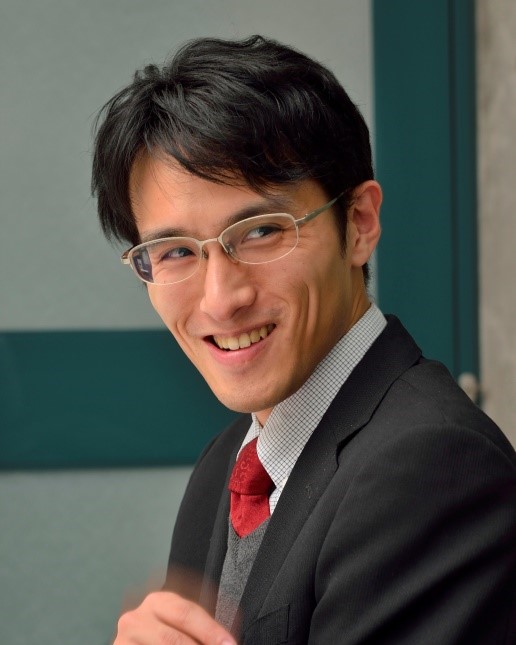
Kazumasa Fujiwara is a second year doctoral student at Waseda University’s Department of Physics and Applied Physics at the Graduate School of Advanced Science and Engineering and a DC1 research fellow of the Japan Society for the Promotion of Science. He won the 6th Ikushi Prize in 2015. While at Waseda University Senior High School, he developed his studies under teacher Tohru Kato in the Super Science High Schools (SSH) program.
- K. Fujiwara,Remark on local solvability of the Cauchy problem for semirelativistic equations,J. Math. Anal. Appl., 432(2015), 744-748.
- K. Fujiwara, T. Ozawa,On a system of semirelativistic equations in the energy space,Commun. Pure Appl. Anal., 14(2015), 1343-1355.
- K. Fujiwara, S. Machihara, T. Ozawa,Well-posedness for the Cauchy problem for a system of semirelativistic equations,Commun. Math. Phys., 338(2015), 367-391.DOI:10.1007/s00220-015-2347-3


